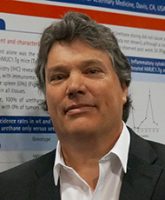In the first part of this series, we spoke with Michelle Bradac, senior accreditation officer at A2LA, to learn the basics of cannabis laboratory accreditation. In the second part, we sat down with Roger Brauninger, A2LA Biosafety Program manager, to learn why states are looking to lab accreditation in their regulations for the cannabis industry.
 In the third part of this series, we sit down with Michael DeGregorio, chief executive officer of Konocti Analytics, Inc., to talk method development in the cannabis testing industry and his experience with getting accredited. In the final part of this series, we are going to sit down with Susan Audino, an instructor at A2LA to learn more about the requirements where she’ll offer some advice for labs seeking accreditation.
In the third part of this series, we sit down with Michael DeGregorio, chief executive officer of Konocti Analytics, Inc., to talk method development in the cannabis testing industry and his experience with getting accredited. In the final part of this series, we are going to sit down with Susan Audino, an instructor at A2LA to learn more about the requirements where she’ll offer some advice for labs seeking accreditation.

Michael DeGregorio is a doctor of pharmacy with an extensive career in medicine and scientific research. He’s worked in cancer research and medicine, teaching at the University of California, San Francisco, Yale University School of Medicine, University of Texas, Health Science Center at San Antonio and University of California, Davis. Before becoming the CEO of Konocti Analytics, a laboratory based in California, DeGregorio was also a published author in a large number of peer-reviewed medical journals.
In this piece, we sit down with DeGregorio to find out what challenges labs face when getting accredited, why they sought accreditation and their experience with getting off the ground. Stay tuned for the final part of this series!
CannabisIndustryJournal: How does a laboratory go about choosing an appropriate method in an industry where, generally, there are no validated methods available?
Michael DeGregorio: Our approach to developing analytical methods for testing cannabis began with a review of the existing laboratories and their methods, where we found no standardization and inconsistent results. Since cannabis is being used by the public and as a medicine, our goal is to help make it as contaminant-free as possible for the well-being of the consumer, and this begins by developing a state-of-the-art analytical facility.
When developing new methods, we review the published literature to see what has already been done and try to arrive at a scientifically sound consensus. We then perform experiments to determine which set of conditions works best for us. Once we have developed an appropriate method, we validate it pursuant to ISO/IEC 17025 requirements.
CIJ: How do you go about choosing what type of equipment to use for testing (e.g. by limit of detection, acceptable method use of equipment for other industries, etc.)?
Michael: After reviewing the operations of other testing laboratories, we concluded that, in general, they were not taking advantage of the most advanced technologies and had limited personnel qualified to operate it. Because public safety is our main concern, we chose state-of-the-art equipment, including GC/LC-MS with Orbitrap and ICP-MS, for testing medicinal cannabis. In addition to identifying unknown pesticides, we needed the capability of performing full chemical screening of all samples for potentially harmful compounds, e.g. steroids, present in cannabis, as well as the ability to detect trace levels of metals.
Our greatest concern is the fact that pesticides in cannabis have not been adequately studied. Current pesticide regulations suggest that government authorities believe that there are a finite number of pesticides available. Smart farmers could easily avoid the pesticides on current lists. Because of this, we chose to validate our pesticide methods with a focus on chemical classes, as opposed to specific pesticides, to give us the broadest possible coverage of potential compounds. The Orbitrap mass spectrometers also allow us to detect and identify unknown pesticides. This is something not currently being done by other laboratories. The latest microbiology methods for cannabis testing include DNA analysis, and for this we use qRT-PCR technology. Finally, the high sensitivity of ICP-MS allows for the detection of metals concentrations that may be harmful, yet undetectable by other means.
CIJ: What do you feel are the benefits of being accredited?
Michael: Being accredited shows the public that we have made a commitment to quality analytics. We feel this gives our clients peace of mind when marketing their products, knowing that they have been tested by a laboratory meeting the highest international standards of operation available using the latest technology. Furthermore, being accredited requires participation in ongoing proficiency testing programs, which helps maintain analytical competency. It should be pointed out that any prospective client of an analytical facility should take into account the laboratory’s full accredited scope of testing to ensure its competency.
CIJ: What challenges did you face during the process of getting your laboratory started and/or during the accreditation process?
Michael: Developing the quality management system and getting our equipment and processes to a state where they met accreditation requirements took several months of hard work, and turned out to be a bit more daunting than we anticipated. Our pre-accreditation assessment revealed that much work remained to be done, and it gave us a real appreciation for the level of detail and documentation required. We remained determined and eventually achieved our accreditation.
CIJ: What are the benefits to the grower and dispensaries to choosing an accredited laboratory for the testing of their product?
Michael: By choosing an accredited laboratory with a full scope of testing (potency, pesticides, mycotoxins, metals, microbiology, residual solvents and terpenes), growers and dispensaries can rest assured that their products have been tested using validated methods with appropriate quality control by trained, competent personnel. For growers, this makes their products more attractive to potential buyers. For dispensaries, this means they can confidently market their products with the knowledge that the information shown on the label is accurate, which in turn gives their customers peace of mind that the product they are consuming does not contain unacceptable levels of contaminants.
CIJ: Why did you choose A2LA?
Michael: Once we decided to pursue accreditation, we researched the various accrediting bodies available as well as their reputations. We discovered that while all accrediting bodies are themselves accredited to the same standard, accreditation by the various bodies was not considered equal in practice. In our opinion, A2LA was considered the most prestigious, highly regarded accrediting body. Furthermore, some of the most prestigious laboratories in the country are accredited by A2LA, including Los Alamos National Laboratory, the Food and Drug Administration’s Center for Biologics Evaluation and Research, Lawrence Livermore National Laboratory, Centers for Disease Control, Federal Bureau of Investigation and the United States Department of Agriculture. Many of our preferred sources of scientific supplies and services are accredited by A2LA as well. As our goal was to be accredited by the best available accrediting body, we chose A2LA.



